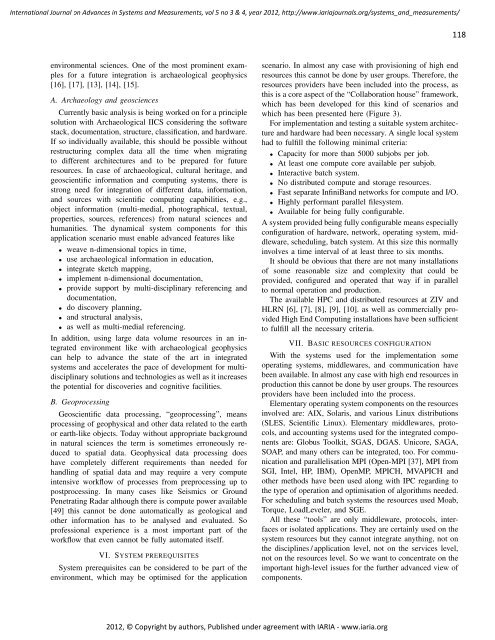c - IARIA Journals
c - IARIA Journals
c - IARIA Journals
Create successful ePaper yourself
Turn your PDF publications into a flip-book with our unique Google optimized e-Paper software.
International Journal on Advances in Systems and Measurements, vol 5 no 3 & 4, year 2012, http://www.iariajournals.org/systems_and_measurements/<br />
environmental sciences. One of the most prominent examples<br />
for a future integration is archaeological geophysics<br />
[16], [17], [13], [14], [15].<br />
A. Archaeology and geosciences<br />
Currently basic analysis is being worked on for a principle<br />
solution with Archaeological IICS considering the software<br />
stack, documentation, structure, classification, and hardware.<br />
If so individually available, this should be possible without<br />
restructuring complex data all the time when migrating<br />
to different architectures and to be prepared for future<br />
resources. In case of archaeological, cultural heritage, and<br />
geoscientific information and computing systems, there is<br />
strong need for integration of different data, information,<br />
and sources with scientific computing capabilities, e.g.,<br />
object information (multi-medial, photographical, textual,<br />
properties, sources, references) from natural sciences and<br />
humanities. The dynamical system components for this<br />
application scenario must enable advanced features like<br />
• weave n-dimensional topics in time,<br />
• use archaeological information in education,<br />
• integrate sketch mapping,<br />
• implement n-dimensional documentation,<br />
• provide support by multi-disciplinary referencing and<br />
documentation,<br />
• do discovery planning,<br />
• and structural analysis,<br />
• as well as multi-medial referencing.<br />
In addition, using large data volume resources in an integrated<br />
environment like with archaeological geophysics<br />
can help to advance the state of the art in integrated<br />
systems and accelerates the pace of development for multidisciplinary<br />
solutions and technologies as well as it increases<br />
the potential for discoveries and cognitive facilities.<br />
B. Geoprocessing<br />
Geoscientific data processing, “geoprocessing”, means<br />
processing of geophysical and other data related to the earth<br />
or earth-like objects. Today without appropriate background<br />
in natural sciences the term is sometimes erroneously reduced<br />
to spatial data. Geophysical data processing does<br />
have completely different requirements than needed for<br />
handling of spatial data and may require a very compute<br />
intensive workflow of processes from preprocessing up to<br />
postprocessing. In many cases like Seismics or Ground<br />
Penetrating Radar although there is compute power available<br />
[49] this cannot be done automatically as geological and<br />
other information has to be analysed and evaluated. So<br />
professional experience is a most important part of the<br />
workflow that even cannot be fully automated itself.<br />
VI. SYSTEM PREREQUISITES<br />
System prerequisites can be considered to be part of the<br />
environment, which may be optimised for the application<br />
scenario. In almost any case with provisioning of high end<br />
resources this cannot be done by user groups. Therefore, the<br />
resources providers have been included into the process, as<br />
this is a core aspect of the “Collaboration house” framework,<br />
which has been developed for this kind of scenarios and<br />
which has been presented here (Figure 3).<br />
For implementation and testing a suitable system architecture<br />
and hardware had been necessary. A single local system<br />
had to fulfill the following minimal criteria:<br />
• Capacity for more than 5000 subjobs per job.<br />
• At least one compute core available per subjob.<br />
• Interactive batch system.<br />
• No distributed compute and storage resources.<br />
• Fast separate InfiniBand networks for compute and I/O.<br />
• Highly performant parallel filesystem.<br />
• Available for being fully configurable.<br />
A system provided being fully configurable means especially<br />
configuration of hardware, network, operating system, middleware,<br />
scheduling, batch system. At this size this normally<br />
involves a time interval of at least three to six months.<br />
It should be obvious that there are not many installations<br />
of some reasonable size and complexity that could be<br />
provided, configured and operated that way if in parallel<br />
to normal operation and production.<br />
The available HPC and distributed resources at ZIV and<br />
HLRN [6], [7], [8], [9], [10]. as well as commercially provided<br />
High End Computing installations have been sufficient<br />
to fulfill all the necessary criteria.<br />
VII. BASIC RESOURCES CONFIGURATION<br />
With the systems used for the implementation some<br />
operating systems, middlewares, and communication have<br />
been available. In almost any case with high end resources in<br />
production this cannot be done by user groups. The resources<br />
providers have been included into the process.<br />
Elementary operating system components on the resources<br />
involved are: AIX, Solaris, and various Linux distributions<br />
(SLES, Scientific Linux). Elementary middlewares, protocols,<br />
and accounting systems used for the integrated components<br />
are: Globus Toolkit, SGAS, DGAS. Unicore, SAGA,<br />
SOAP, and many others can be integrated, too. For communication<br />
and parallelisation MPI (Open-MPI [37], MPI from<br />
SGI, Intel, HP, IBM), OpenMP, MPICH, MVAPICH and<br />
other methods have been used along with IPC regarding to<br />
the type of operation and optimisation of algorithms needed.<br />
For scheduling and batch systems the resources used Moab,<br />
Torque, LoadLeveler, and SGE.<br />
All these “tools” are only middleware, protocols, interfaces<br />
or isolated applications. They are certainly used on the<br />
system resources but they cannot integrate anything, not on<br />
the disciplines / application level, not on the services level,<br />
not on the resources level. So we want to concentrate on the<br />
important high-level issues for the further advanced view of<br />
components.<br />
2012, © Copyright by authors, Published under agreement with <strong>IARIA</strong> - www.iaria.org<br />
118







